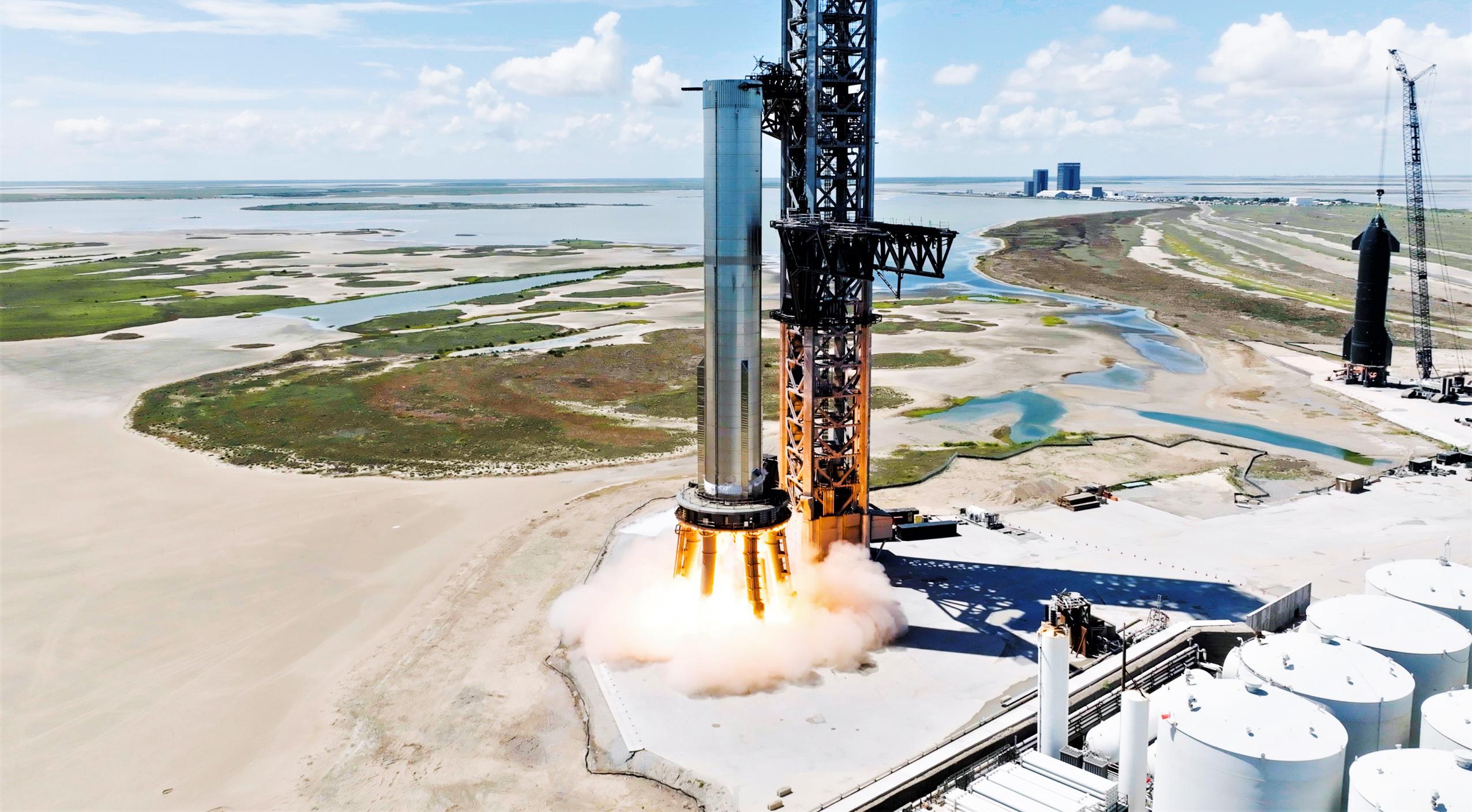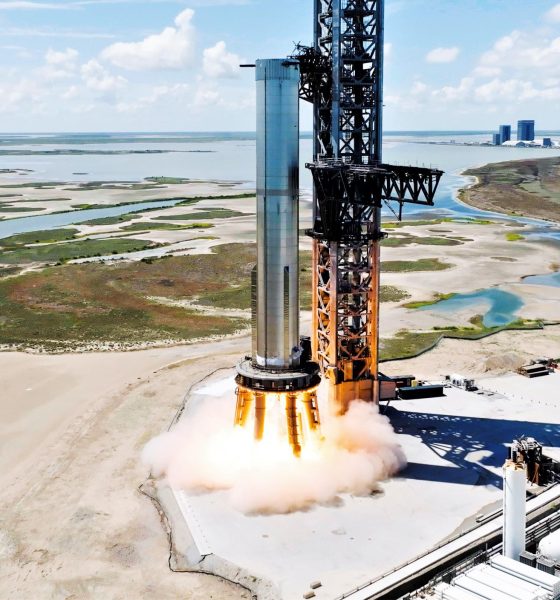

News
SpaceX breaks Starship test record, rolls next booster to launch pad
SpaceX has completed a record-breaking test of a Starship booster and rolled a newer Super Heavy prototype to the launch pad just hours apart.
Almost six weeks after SpaceX began Super Heavy Booster 7’s static fire test campaign, the company has broken new ground by simultaneously igniting seven Raptor engines at once. A matter of hours later, confirming SpaceX CEO Elon Musk’s plans in real time, the company transported a second Super Heavy prototype (Booster 8) from the factory to the launch pad, where it joined Booster 7.
According to Musk, those rockets will soon switch places, ensuring that no time is wasted while SpaceX continues to gradually work towards Starship’s first orbital launch attempts.
Booster 7 kicked off the most important stage of its flight qualification process on August 9th and 11th with two back-to-back static fires, each igniting just one of 20 installed Raptor engines. Both appeared to be successful and SpaceX returned B7 to its Boca Chica, Texas factory, reinstalled a full set of 33 engines, and sent the Super Heavy back to the launch pad two weeks later.
On August 31st, SpaceX attempted to ignite three of Booster 7’s 33 Raptors. One engine failed to ignite but the others did not, resulting in a mostly successful two-engine test. Over the next two weeks, SpaceX performed several ignition-free ‘spin-prime’ tests, two of which appeared to spin up all 33 engines without causing an explosion. Finally, SpaceX telegraphed its next major goal with a seven-engine spin-prime test on September 16th and another (albeit with a slightly different set of engines) on September 19th.
Shortly after the second seven-engine spin-prime, SpaceX refilled Booster 7 with propellant, went back through the same procedures, and ignited the same seven engines for about five seconds. No obvious issues arose and Musk later implied that the test went well. It set a new record for the largest number of Raptors simultaneously ignited on a single prototype and likely also broke the record for most thrust produced by a vehicle tested at Starbase.
If all seven upgraded Raptor V2 engines were operating at full throttle, they could have briefly produced more than 1600 tons (~3.6M lbf) of thrust – roughly equivalent to two Falcon 9 boosters. Measuring about 69 meters (~225 ft) tall and 9 meters (~30 ft) wide, Super Heavy will be the most powerful liquid rocket booster ever tested once it ignites as few as 20 of its 33 engines at full thrust.
In an increasingly rare update, Musk revealed that SpaceX will once again return Booster 7 to Starbase’s factory for mysterious “robustness upgrades” after the latest round of testing. Musk doesn’t seem to think that those upgrades will take very long, and anticipates that Starbase’s “next big test” will be the first complete wet dress rehearsal of a fully-assembled two-stage Starship, followed by Super Heavy’s first 33-engine static fire test, “in a few weeks.”
More likely than not, each step of that process will take multiple attempts and uncover issues that will then need to be corrected and verified over the course of several months. But with Starship 24 having already completed a full six-engine static fire, there’s a small chance SpaceX will find itself with a fully-stacked Starship that is more or less ready for its first orbital launch attempt by the end of October.
In the meantime, after Booster 7 returns to the factory, Booster 8 – finally complete after a relatively slow six-month assembly – will kick off basic proof testing at SpaceX’s South Texas orbital launch site. SpaceX wasted no time preparing for that swap and transported Booster 8 to the pad just seven hours after Booster 7’s seven-engine static fire. If things move more smoothly than they did with B7, it’s possible that B8 will complete proof testing and be ready to head back to the factory for Raptor installation by the time B7’s upgrades are finished – a very efficient transition if it works out that way.

News
Tesla FSD fleet is nearing 7 billion total miles, including 2.5 billion city miles
As can be seen on Tesla’s official FSD webpage, vehicles equipped with the system have now navigated over 6.99 billion miles.

Tesla’s Full Self-Driving (Supervised) fleet is closing in on almost 7 billion total miles driven, as per data posted by the company on its official FSD webpage.
These figures hint at the massive scale of data fueling Tesla’s rapid FSD improvements, which have been quite notable as of late.
FSD mileage milestones
As can be seen on Tesla’s official FSD webpage, vehicles equipped with the system have now navigated over 6.99 billion miles. Tesla owner and avid FSD tester Whole Mars Catalog also shared a screenshot indicating that from the nearly 7 billion miles traveled by the FSD fleet, more than 2.5 billion miles were driven inside cities.
City miles are particularly valuable for complex urban scenarios like unprotected turns, pedestrian interactions, and traffic lights. This is also the difference-maker for FSD, as only complex solutions, such as Waymo’s self-driving taxis, operate similarly on inner-city streets. And even then, incidents such as the San Francisco blackouts have proven challenging for sensor-rich vehicles like Waymos.
Tesla’s data edge
Tesla has a number of advantages in the autonomous vehicle sector, one of which is the size of its fleet and the number of vehicles training FSD on real-world roads. Tesla’s nearly 7 billion FSD miles then allow the company to roll out updates that make its vehicles behave like they are being driven by experienced drivers, even if they are operating on their own.
So notable are Tesla’s improvements to FSD that NVIDIA Director of Robotics Jim Fan, after experiencing FSD v14, noted that the system is the first AI that passes what he described as a “Physical Turing Test.”
“Despite knowing exactly how robot learning works, I still find it magical watching the steering wheel turn by itself. First it feels surreal, next it becomes routine. Then, like the smartphone, taking it away actively hurts. This is how humanity gets rewired and glued to god-like technologies,” Fan wrote in a post on X.
News
Tesla starts showing how FSD will change lives in Europe
Local officials tested the system on narrow country roads and were impressed by FSD’s smooth, human-like driving, with some calling the service a game-changer for everyday life in areas that are far from urban centers.

Tesla has launched Europe’s first public shuttle service using Full Self-Driving (Supervised) in the rural Eifelkreis Bitburg-Prüm region of Germany, demonstrating how the technology can restore independence and mobility for people who struggle with limited transport options.
Local officials tested the system on narrow country roads and were impressed by FSD’s smooth, human-like driving, with some calling the service a game-changer for everyday life in areas that are far from urban centers.
Officials see real impact on rural residents
Arzfeld Mayor Johannes Kuhl and District Administrator Andreas Kruppert personally tested the Tesla shuttle service. This allowed them to see just how well FSD navigated winding lanes and rural roads confidently. Kruppert said, “Autonomous driving sounds like science fiction to many, but we simply see here that it works totally well in rural regions too.” Kuhl, for his part, also noted that FSD “feels like a very experienced driver.”
The pilot complements the area’s “Citizen Bus” program, which provides on-demand rides for elderly residents who can no longer drive themselves. Tesla Europe shared a video of a demonstration of the service, highlighting how FSD gives people their freedom back, even in places where public transport is not as prevalent.
What the Ministry for Economic Affairs and Transport says
Rhineland-Palatinate’s Minister Daniela Schmitt supported the project, praising the collaboration that made this “first of its kind in Europe” possible. As per the ministry, the rural rollout for the service shows FSD’s potential beyond major cities, and it delivers tangible benefits like grocery runs, doctor visits, and social connections for isolated residents.
“Reliable and flexible mobility is especially vital in rural areas. With the launch of a shuttle service using self-driving vehicles (FSD supervised) by Tesla in the Eifelkreis Bitburg-Prüm, an innovative pilot project is now getting underway that complements local community bus services. It is the first project of its kind in Europe.
“The result is a real gain for rural mobility: greater accessibility, more flexibility and tangible benefits for everyday life. A strong signal for innovation, cooperation and future-oriented mobility beyond urban centers,” the ministry wrote in a LinkedIn post.
News
Tesla China quietly posts Robotaxi-related job listing
Tesla China is currently seeking a Low Voltage Electrical Engineer to work on circuit board design for the company’s autonomous vehicles.

Tesla has posted a new job listing in Shanghai explicitly tied to its Robotaxi program, fueling speculation that the company is preparing to launch its dedicated autonomous ride-hailing service in China.
As noted in the listing, Tesla China is currently seeking a Low Voltage Electrical Engineer to work on circuit board design for the company’s autonomous vehicles.
Robotaxi-specific role
The listing, which was shared on social media platform X by industry watcher @tslaming, suggested that Tesla China is looking to fill the role urgently. The job listing itself specifically mentions that the person hired for the role will be working on the Low Voltage Hardware team, which would design the circuit boards that would serve as the nervous system of the Robotaxi.
Key tasks for the role, as indicated in the job listing, include collaboration with PCB layout, firmware, mechanical, program management, and validation teams, among other responsibilities. The role is based in Shanghai.
China Robotaxi launch
China represents a massive potential market for robotaxis, with its dense urban centers and supportive policies in select cities. Tesla has limited permission to roll out FSD in the country, though despite this, its vehicles have been hailed as among the best in the market when it comes to autonomous features. So far, at least, it appears that China supports Tesla’s FSD and Robotaxi rollout.
This was hinted at in November, when Tesla brought the Cybercab to the 8th China International Import Expo (CIIE) in Shanghai, marking the first time that the autonomous two-seater was brought to the Asia-Pacific region. The vehicle, despite not having a release date in China, received a significant amount of interest among the event’s attendees.








